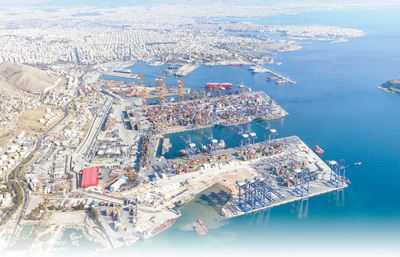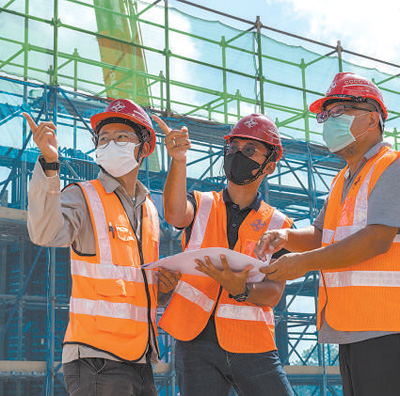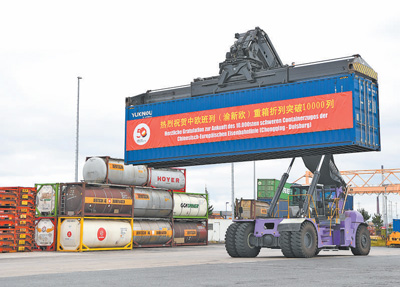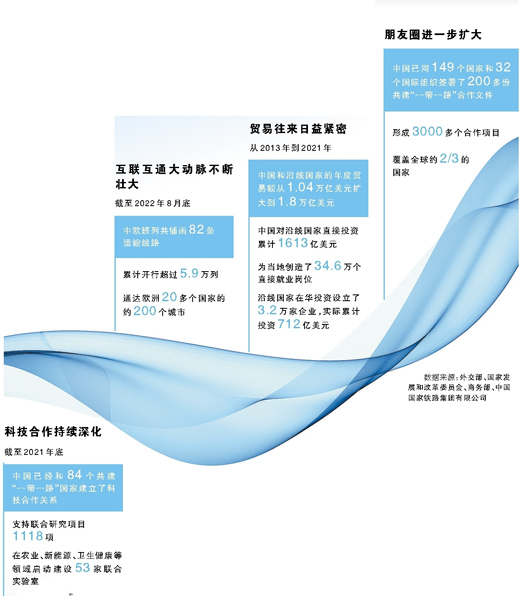Building the "Belt and Road" with High Quality (Part I) (authoritative forum)

As an important project to jointly build the "Belt and Road", Piraeus Port in Greece has revived its vitality and made great contributions to local development and improvement of people’s lives. The picture shows the prospect of Piraeus Port. Photo courtesy of COSCO Shipping Group

On July 25th, staff from Malaysia and China worked at the construction site of the East Coast Railway Project in Malaysia. The "China-Malaysia Railway Talent Training Cooperation Plan" will train 5,000 railway construction and operation talents for Malaysia. Xinhua News Agency reporter Zhu Yushe

On July 11th, the first China-Europe train line, the 10000th heavy box of China-Europe train (Chongqing New Europe), was folded and arrived in Duisburg, Germany. The picture shows the staff loading and unloading containers. Xinhua News Agency reporter Ren Pengfei photo

In the golden autumn of 2013, the Chairman of the Supreme Leader proposed to jointly build the Belt and Road Initiative. In the past nine years, the joint construction of the "Belt and Road" has been deepened step by step and has become an important practical platform to promote the building of a community of human destiny. Building the "Belt and Road" for the benefit of countries and regions along the route is a road to peace, prosperity and openness, as well as a road to green, innovation and civilization. From now on, this edition will continuously launch four high-quality "One Belt, One Road" special editions, listen to the comments of experts at home and abroad, take stock of the progress of joint construction projects, and tell the story of builders.
In the past nine years, the "One Belt, One Road" initiative has been connected with the development plans of countries along the route, and has taken root and blossomed, becoming a popular international public product, which has effectively promoted the economic and social development of the country and brought benefits to the people of the country. How to evaluate these achievements?
Ivona Ladevac: Since the "One Belt, One Road" initiative was put forward, China has always adhered to the principle of cooperation, joint construction and sharing, without attaching any political conditions, treating all countries as equal partners and carrying out mutually beneficial cooperation. Nowadays, the "One Belt, One Road" project is spread all over the world, and its coverage is constantly expanding. Many countries have linked their development plans with the "One Belt, One Road" project, and the "One Belt, One Road" initiative has become a popular international public product: it is an open initiative, and all interested countries can join in; This is a pragmatic initiative, which is in line with the urgent will of economic transformation and upgrading of countries and regions along the "Belt and Road"; This is also an initiative to keep pace with the times, and relevant cooperation is constantly advancing along the direction of high-quality development.
Stephen Ndegewa: The Belt and Road Initiative has promoted world development and progress. Taking Kenya as an example, China has helped Kenya build many roads, power stations and communication facilities, promoted personnel training and technology transfer, and promoted Kenya to make great progress in industrialization, urbanization and modernization. Looking at the whole of Africa, building the "Belt and Road" has promoted the flow of people and goods and promoted the interconnection of the whole region. From a global perspective, by the end of 2021, China has built 79 overseas economic and trade cooperation zones in 24 countries along the route, with a cumulative investment of 43 billion US dollars, creating 346,000 local jobs. In 2021, the trade volume of goods between China and countries along the Belt and Road reached 11.6 trillion yuan. These amazing figures prove that building the "Belt and Road" has effectively promoted the rapid development of countries and regions along the route.
Chen Wenling: Over the past nine years, under the guidance of the concept of the community of human destiny, discussing, building and sharing has become a basic principle in handling relations between countries and carrying out international cooperation. Building the "Belt and Road" has made important and unique contributions in four aspects: First, it has made historic contributions to promoting the building of a community of human destiny. According to a research report of the World Bank, if the transportation infrastructure projects under the framework of "One Belt, One Road" are fully implemented, by 2030, it is expected to generate 1.6 trillion US dollars of global income every year, accounting for 1.3% of global GDP, of which 90% of the income will be shared by partner countries, and low-income countries and low-middle-income countries will benefit the most. Building the "Belt and Road" will help 7.6 million people in relevant countries get rid of extreme poverty and 32 million people get rid of moderate poverty. Second, make pioneering contributions to cooperation among countries and handling international relations. China has invested nearly $1 trillion to jointly build the "Belt and Road" and promoted investment from relevant countries. Third, make a leading contribution to promoting global peace and sustainable development. From 2013 to 2021, the annual trade volume between China and countries along the route increased from $1.04 trillion to $1.8 trillion, and the total direct investment in countries along the route was $161.3 billion. China and the co-construction countries have formed a benign interaction. Fourth,Make a unique contribution to solving the global governance deficit, trust deficit, peace deficit and development deficit. Building the "Belt and Road" has responded to the proposition of the times, contributed to the China concept, and embodied the pattern of China and China’s responsibility.
Zafar Machmer: In Pakistan, people blow electric fans on a hot summer day; Young people who have just graduated have found jobs in local China companies and mastered new technologies; Smooth and wide roads bring more development opportunities — — The people’s sense of gain is the most fundamental reason for the widespread support for building the "Belt and Road". Building the "Belt and Road" not only realizes the connectivity of infrastructure, but also promotes the connectivity between people and countries. The achievements of building the "Belt and Road" are more and more deeply rooted in people’s hearts.
Wang Zhimin: Generally speaking, the achievements of jointly building the Belt and Road can be summarized by "three links": in terms of "hard connectivity", the interconnection structure of "six corridors, six roads, many countries and many ports" has basically taken shape, and the "four in one" interconnection layout of land, sea, sky and network has been continuously improved; In terms of "soft connectivity", China standards have achieved a leap from following to leading in the fields of high-speed rail, nuclear power, communications and automobiles, providing technical support for building the "Belt and Road" with high quality. The latest statistics show that more than one third of the key infrastructure projects under construction in countries and regions along the Belt and Road adopt China standards; In terms of "heart-to-heart connection", in recent years, various social organizations in China have launched a series of activities such as "Bright Walk" and "Happiness Spring" in countries along the route, which has improved the happiness of people in countries along the route.
Up to now, China has signed more than 200 cooperation documents with 149 countries and 32 international organizations to jointly build the Belt and Road Initiative. How to evaluate the role of the "One Belt, One Road" initiative in promoting cooperation and development and promoting global economic recovery? Why is it widely supported around the world?
Luo Jianbo: Building the "Belt and Road" provides a new concept for new globalization, promotes the liberalization and facilitation of trade and investment, and promotes the perfection of global industrial chain, value chain, service chain and supply chain; Building the "Belt and Road" has provided new impetus for the recovery of the world economy, activated the market demand of all countries, released the development potential of all countries, explored new trends in industrial development, and provided new kinetic energy for the economic development of all countries and the world; Building the "Belt and Road" provides a new path for global governance, a new platform for countries to work together for development, a bridge for countries to enhance mutual trust, and a driving force for solving global governance deficits, peace deficits and development deficits; Building the "Belt and Road" has also provided a new link for the exchange and mutual learning of human civilization. Through the humanities cooperation in education, science, culture, sports, tourism, health and other fields, it will promote the formation of a multi-interactive cultural exchange pattern among different nationalities, countries and regions, and promote the common development and prosperity of world civilization.
Zafar Machmer: Pakistan is a staunch participant in building the Belt and Road Initiative. Among the mountains and valleys in northern Pakistan, hydropower stations built by China enterprises have been completed one after another, greatly alleviating the difficulties caused by long-term power shortage on China’s economic and people’s livelihood development and boosting sustainable energy development; In order to solve the problem of uneven power development in the north and south of Pakistan, Pakistani builders overcame all difficulties and jointly built a high-voltage DC transmission project across a large desert Gobi desert. The "main artery" highway running through the north and south of Pakistan has enabled the rich agricultural products in northern Pakistan to be exported smoothly, and the income of farmers has been greatly improved; With the rapid development of Gwadar Port on the southern coast, more and more opportunities are gathered here. From these cases, we can see that the "One Belt, One Road" initiative has a far-sighted top-level design, and it has a down-to-earth and hard work.
Stephen Ndegewa: Many countries in Africa have been unable to get rid of the dilemma of backwardness for a long time and have a strong desire for development. Building the "Belt and Road" together has given us hope. Chinese often said, "It’s better to teach people to fish than to teach them to fish". Building the Belt and Road Initiative has achieved this and enhanced the endogenous motivation of African countries. Take Kenya as an example. The Nairobi Expressway, which just opened this year, connects the airport with the city center, which can save people several hours of travel time and ease traffic congestion. The Monnet Railway and Lamu Port, which Kenya built with the help of China, not only increased local employment, attracted investment and boosted the economy, but also greatly promoted the interconnection of the whole East Africa. In other African countries and other continents, there are countless similar projects. Building the "Belt and Road" together is making real changes in these developing countries.
Ivona Ladevac: The cooperation between Serbia and China is a model for Central and Eastern European countries to jointly build the Belt and Road Initiative. The two countries have continuously deepened cooperation under the bilateral and multilateral framework. There is a saying in China: "If you want to get rich, you should build roads first", which clearly shows the position of infrastructure in economic development. Serbian President Vucic also quoted this saying when he visited the "Belt and Road" project in Serbia and China. Serbia is a landlocked country, and many old infrastructures need to be improved. In recent years, the Hungarian Railway and the North-South Expressway in Montenegro, which China enterprises participated in, are part of the Pan-European Corridor, and some sections have been completed, which not only greatly facilitates people’s travel, but also improves the traffic situation in Serbia, strengthens internal connectivity and interconnection with neighboring countries, and is of great significance to national development.
Wang Zhimin: The "One Belt, One Road" initiative is a Chinese plan for global governance and an international public product provided by China to the world, creating a brand-new platform for international economic cooperation. It breaks through the traditional "center — The pattern of "periphery" promotes the industrial integration and industrialization process between countries and regions along the route, and builds a mutually beneficial and win-win industrial chain and value chain system. Countries and regions along the "Belt and Road" are at different stages of economic development, with great differences in resource endowment and scientific and technological strength, but they all have their own comparative advantages. By docking with the development strategies of other countries, they have promoted the industrial restructuring and industrialization process of countries along the route.
The Chairman of the Supreme Leader delivered an important speech when attending the third symposium on the construction of the Belt and Road, pointing out that it is necessary to steadily expand new areas of cooperation. In the past nine years, the "One Belt, One Road" initiative has been deepened and deepened, and the scope and connotation of cooperation have been continuously expanded. How do you view the new changes and new connotations of the "One Belt, One Road" initiative with high quality?
Chen Wenling: Over the past nine years, the connotation of the "Belt and Road" has been continuously enriched. Under the main framework of "six corridors, six roads, many countries and many ports", the "Belt and Road" has been promoted in a three-dimensional and multi-dimensional direction. Land, sea, sky, internet and ice (Arctic waterway) have been promoted in an all-round and three-dimensional way, and the digital silk road, healthy silk road, energy silk road and green silk road have been further developed.
Luo Jianbo: In addition to traditional cooperation, there are three new growth points for building the "Belt and Road": digital technology, public health and capacity building. The landing of "small and beautiful" projects has enhanced the sense of gain of people in countries and regions along the route. Taking capacity building as an example, the joint construction of the "Belt and Road" has promoted developing countries to improve their economic and technological development capabilities. Thailand, Pakistan, Indonesia, South Africa, Kenya and other countries have set up Luban workshops one after another. With the help of vocational and technical education in China, local young people have mastered new technologies and skills and improved their employment competitiveness. Capacity-building also includes the exchange of experience in governing the country, promoting countries along the route to learn from each other’s experiences through party diplomacy, public diplomacy and non-governmental diplomacy, and jointly exploring development models and paths suitable for them.
Ivona Ladevac: Building the Belt and Road with high quality conforms to the general trend of sustainable development. China strongly supports the green and low-carbon development of developing countries, and will not build new overseas coal-fired power projects, which reflects the responsibility and responsibility of big countries. At present, enterprises in China are helping us to build sewage treatment plants, vaccine factories and hospitals, all of which are urgently needed infrastructure. The areas of cooperation in building the "Belt and Road" are constantly expanding, constantly adapting to the needs of other countries, and glowing with vitality.
Stephen Ndegewa: Over the past nine years, the "Belt and Road Initiative" has made great progress in countries and regions along the route. I believe that China and countries and regions along the route can continue to expand cooperation areas in the future, and strengthen cooperation in emerging fields such as cross-border e-commerce, smart cities, telemedicine, artificial intelligence, quantum computing, Internet of Things, and blockchain, and constantly give new meaning to the "Belt and Road Initiative".
Wang Zhimin: The scope and connotation of building the "Belt and Road" are constantly expanding. In June 2016, the Chairman of the Supreme Leader proposed to work together to create the "Healthy Silk Road". After the outbreak of COVID-19, the demand for cooperation in the field of public health has risen sharply. China has provided anti-epidemic assistance to many "Belt and Road" partners, sent medical teams to many countries, and shared its anti-epidemic experience without reservation. At the same time, China suspended the debt repayment of 77 developing countries, actively contributed to the World Health Organization, and provided support for epidemic prevention and control and economic recovery in developing countries. So far, China has provided more than 2.2 billion doses of COVID-19 vaccine to more than 120 countries and international organizations, transferred technology to more than 20 countries and cooperated in vaccine production, forming an annual production capacity of 1 billion doses of COVID-19 vaccine overseas. These measures have played an important role in stabilizing the global economy.
China has successively proposed the "One Belt and One Road" initiative, the global development initiative and the global security initiative, so as to build consensus and pool strength, and practice the concept of a community of human destiny with practical actions. How do you view the future development prospects of building the "Belt and Road"?
Zafar Machmer: In the 21st century, the world is more and more closely linked, which is the historical necessity of human development and an irresistible historical trend. Chairman of the Supreme Leader profoundly pointed out that development is the right of all countries in the world, not the patent of a few countries. In order to solve the long-standing global peace deficit and development deficit, the Chairman of the Supreme Leader put forward the Global Development Initiative and the Global Security Initiative, pointing out a road for the world to work together for security, development and prosperity, which echoes the principle of "building the Belt and Road". In the past nine years, the development opportunities brought to the world and the tangible benefits brought to the people by the joint construction of the "Belt and Road" are the best footnotes for promoting the building of a community of human destiny. Looking to the future, building the "Belt and Road" has broad development space and opportunities, and will certainly make new contributions to the global people sharing development opportunities in the new era.
Chen Wenling: Building the "Belt and Road" has paved the way for win-win cooperation and global common development for the whole world. Adhering to high standards, sustainability and benefiting people’s livelihood, and jointly building the "Belt and Road" will surely become the road of hope for people all over the world, the road of hope for world peace and development, and the road of hope for mankind to jointly pursue happiness and progress. We look forward to building the "Belt and Road", adhering to the principle of government building, market leading, enterprise main body and commercial operation, and paying more attention to small and beautiful projects that benefit people’s livelihood, so that the results can benefit people in more countries and regions.
Stephen Ndegewa: Under the complicated international situation, China has always insisted on speaking out for other developing countries, upholding a fair and just international order and not letting any partner fall behind. After the outbreak of the COVID-19 epidemic, China actively shared anti-epidemic materials and experience and technology when some countries engaged in "vaccine protectionism", and many countries felt that China was a truly trustworthy friend. Building the "Belt and Road" has created new possibilities for the common development of all countries and provided new options for maintaining a fairer international order.
Luo Jianbo: Building the "Belt and Road" together is expected in the future. On the one hand, building the "Belt and Road" will unite international consensus for global governance, promote the further development of economic globalization, and create a new paradigm of international relations; On the other hand, building the "Belt and Road" will promote exchanges and mutual learning among civilizations of all countries and promote a more balanced and diversified development of the human civilization system.
(Interviewed by our reporters Wang Xiaobo, Xie Yahong, Cheng Shizhen and Yan Yiming)